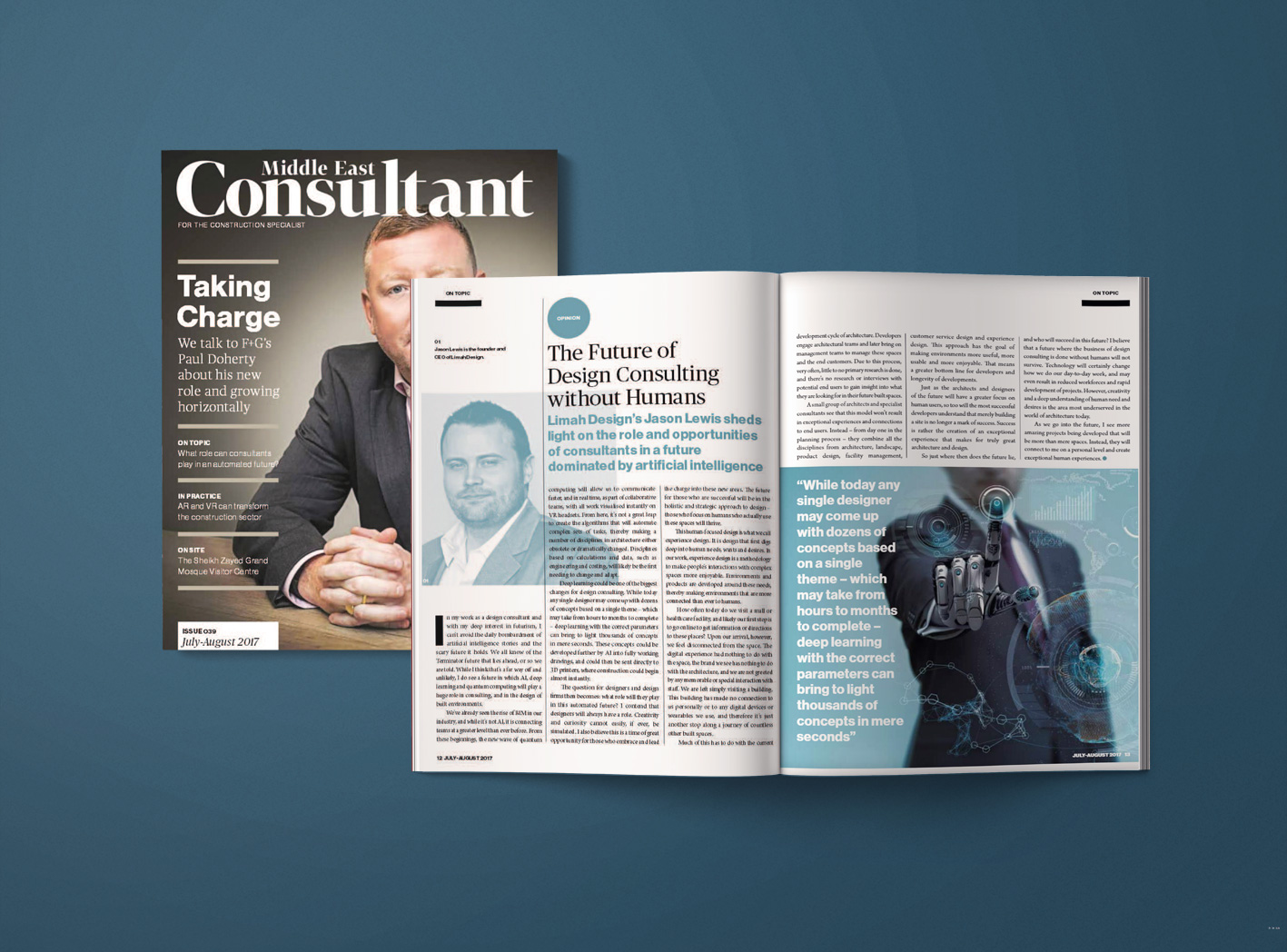The Future of Design Consulting Without Humans
Jason Lewis, Founder & CEO of LIMAH sheds lights on the role of design in an AI dominated future in MEC Magazine.
In my work as a design consultant and my deep interest in futurism, I can’t avoid the daily bombardment of Artificial Intelligence stories and the scary future it holds. We all know of the Terminator future that lies ahead, or so we are told. While I think that’s a far way off and unlikely, I do see a future in which AI, Deep Learning, and Quantum Computing will play a huge role in consulting and the design of built environments.
We’ve already have seen the rise of BIM in our industry, and while it’s not AI, it is connecting teams at a greater level than ever before. From these beginnings, the new wave of quantum computing will allow us to communicate faster in real time as part of collaborative teams, all work visualized instantly from our VR headsets. From here it’s not a great leap to create the algorithms that will automate complex sets of tasks, thereby making a number of disciplines in architecture either obsolete or dramatically changed. Those disciplines based on calculations and data such as engineering or costing, likely being the first needing to change and adapt.

Deep Learning could be one of the biggest changes in design consulting. While today any single designer may come up with dozens of concepts based on a single theme – which may take them hours to months to complete – deep learning, with the correct parameters, can bring to light 1000’s of concepts in seconds. These concepts could be developed further by AI into fully working drawings, sent directly to 3D printers where construction can begin almost instantly.
The question for designers and design firms then becomes what role will they play in this automated future? I contend that designers will always have a role. Creativity and curiosity is not something that can easily if ever be simulated. I also believe this a time of great opportunity for those who embrace and lead the charge into these new areas. The future then for those who will be successful will be in the holistic and strategic approach to design. Those who focus on the humans who will actually use these spaces will thrive.
This human-focused design is what we call experience design. It is design that first digs deep into human’s needs, wants and desires. In our work Experience design is a methodology to make people’s interactions with complex spaces more enjoyable. Environments and products are developed around these needs, thereby making environments that are more connected than ever to humans.
How often today do we visit a mall or healthcare facility and likely our first step was to go online to get information or directions to these places? Upon our arrival, however, we feel disconnected to the space. The digital experience had nothing to do with the space, the brand we see has nothing to do with the architecture, and we are not greeted by any memorable or special interaction with staff. We are left then simply visiting a building. This building made no connection to us personally or any digital devices or wearables we use and therefore it’s just another stop along a journey of countless other built spaces.
Much of this has to do with the current development cycle of architecture. Developers engage architectural teams, and later bring on management teams to manage these spaces and the end customers. Due to this process often little to no primary research is done. That is researching and interviewing with the potential end users to gain insight into what they are looking for in their future built spaces.
A small group of architects and specialist consultants, however, see this model won’t result in exceptional experiences and connections to the end users. Rather they from day one in the planning process combine all disciplines from architecture, landscape, product design, facility management, customer service design, and experience design. This approach has the goal of making environments more useful, more usable and more enjoyable. That means a greater bottom line to developers and longevity of developments.
Just as the architects and designers of the future will have a greater focus on human users, so too, the most successful developers will understand that merely building a site is no longer a mark of success. It is rather the creation of an exceptional experience that will make for truly great architecture and design.
So just where then does the future lie, and who will succeed in this future? I believe that the future in the business of design consulting without humans would be its demise. Technology will certainly change how we do our day to day work. It may even result in reduced workforces and rapid development of projects. However, creativity and a deep understanding of human need and desires is the area most underserved in the world of architecture today.
As we go into the future I see more amazing projects being developed that will be more than mere spaces, they will rather connect to me on a personal level and create exceptional human experiences.
View the original article as it appears in the MEC magazine here.
Can I help you create an exceptional human experience? Connect with me @ limahdesign.com or @monopolyofone

